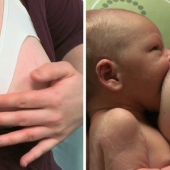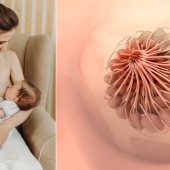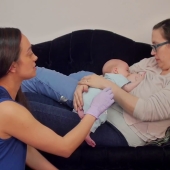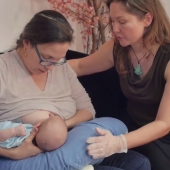Breast milk is the best nutrition for babies, and it’s recommended that your baby is fed on breast milk alone for the first six months. Here, you’ll find our useful breastfeeding tips for getting off to a great start.
Each nipple has 15 to 20 lobes of milk making glandular tissue, made up of clusters of alveoli. From these lobes run special channels called ducts which form into sinuses beneath the areola . From here the milk can flow out of the openings in the nipple . The nipple and areola (the dark area around the nipple) get bigger and darker during pregnancy.
On the areola there are small bumps called Montgomery Glands . These produce a natural oil which cleans, lubricates, and protects the nipple during pregnancy and breastfeeding. This oil contains an enzyme that kills bacteria. So no need for protective creams, lotions and potions ladies, it’s there already. The best way to keep this wonderful natural protection is to wash the breast with water only and take care while drying, don’t rub the nipples, pat them dry.
The breast consists mostly of connective and fatty tissues that support and protect the milk producing areas of the breast. The milk is produced in small clusters of cells, called alveoli and travels down milk ducts to the milk sinuses, which collect and store the milk until it is needed. These sinuses are located behind the areola.
When your baby begins to breastfeed, the nipple is drawn back into the back of the mouth and is held there by suction so that the sinuses are between the upper and lower jaw. The action of the tongue and jaw squeeze the sinuses forcing the milk into the baby’s mouth.
The tongue should lie over the bottom gum. The further back into the baby’s mouth the nipple is, the less likely it is to cause pain or discomfort. You can test this effect yourself. Try sucking on your own thumb, the deeper the thumb goes into the mouth, the more comfortable it feels.
About video: While breastfeeding might come naturally to some moms, for others it might be difficult or painful. Learn more about how to breastfeed in this video.
- 106 views













